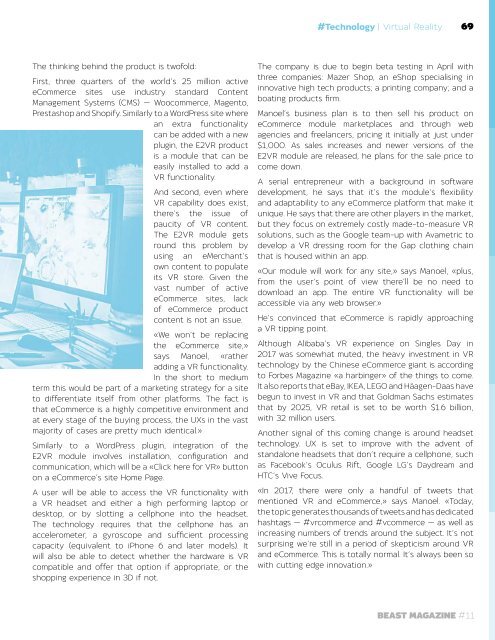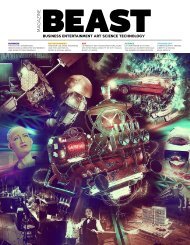Magazine_BEAST_2018_Edition_11_complet.compressed
Create successful ePaper yourself
Turn your PDF publications into a flip-book with our unique Google optimized e-Paper software.
#Technology | Virtual Reality<br />
69<br />
The thinking behind the product is twofold:<br />
First, three quarters of the world’s 25 million active<br />
eCommerce sites use industry standard Content<br />
Management Systems (CMS) — Woocommerce, Magento,<br />
Prestashop and Shopify. Similarly to a WordPress site where<br />
an extra functionality<br />
can be added with a new<br />
plugin, the E2VR product<br />
is a module that can be<br />
easily installed to add a<br />
VR functionality.<br />
And second, even where<br />
VR capability does exist,<br />
there’s the issue of<br />
paucity of VR content.<br />
The E2VR module gets<br />
round this problem by<br />
using an eMerchant’s<br />
own content to populate<br />
its VR store. Given the<br />
vast number of active<br />
eCommerce sites, lack<br />
of eCommerce product<br />
content is not an issue.<br />
«We won’t be replacing<br />
the eCommerce site,»<br />
says Manoel, «rather<br />
adding a VR functionality.<br />
In the short to medium<br />
term this would be part of a marketing strategy for a site<br />
to differentiate itself from other platforms. The fact is<br />
that eCommerce is a highly competitive environment and<br />
at every stage of the buying process, the UXs in the vast<br />
majority of cases are pretty much identical.»<br />
Similarly to a WordPress plugin, integration of the<br />
E2VR module involves installation, configuration and<br />
communication, which will be a «Click here for VR» button<br />
on a eCommerce’s site Home Page.<br />
A user will be able to access the VR functionality with<br />
a VR headset and either a high performing laptop or<br />
desktop, or by slotting a cellphone into the headset.<br />
The technology requires that the cellphone has an<br />
accelerometer, a gyroscope and sufficient processing<br />
capacity (equivalent to iPhone 6 and later models). It<br />
will also be able to detect whether the hardware is VR<br />
compatible and offer that option if appropriate, or the<br />
shopping experience in 3D if not.<br />
The company is due to begin beta testing in April with<br />
three companies: Mazer Shop, an eShop specialising in<br />
innovative high tech products; a printing company; and a<br />
boating products firm.<br />
Manoel’s business plan is to then sell his product on<br />
eCommerce module marketplaces and through web<br />
agencies and freelancers, pricing it initially at just under<br />
$1,000. As sales increases and newer versions of the<br />
E2VR module are released, he plans for the sale price to<br />
come down.<br />
A serial entrepreneur with a background in software<br />
development, he says that it’s the module’s flexibility<br />
and adaptability to any eCommerce platform that make it<br />
unique. He says that there are other players in the market,<br />
but they focus on extremely costly made-to-measure VR<br />
solutions, such as the Google team-up with Avametric to<br />
develop a VR dressing room for the Gap clothing chain<br />
that is housed within an app.<br />
«Our module will work for any site,» says Manoel, «plus,<br />
from the user’s point of view there’ll be no need to<br />
download an app. The entire VR functionality will be<br />
accessible via any web browser.»<br />
He’s convinced that eCommerce is rapidly approaching<br />
a VR tipping point.<br />
Although Alibaba’s VR experience on Singles Day in<br />
2017 was somewhat muted, the heavy investment in VR<br />
technology by the Chinese eCommerce giant is according<br />
to Forbes <strong>Magazine</strong> «a harbinger» of the things to come.<br />
It also reports that eBay, IKEA, LEGO and Häagen-Daas have<br />
begun to invest in VR and that Goldman Sachs estimates<br />
that by 2025, VR retail is set to be worth $1.6 billion,<br />
with 32 million users.<br />
Another signal of this coming change is around headset<br />
technology. UX is set to improve with the advent of<br />
standalone headsets that don’t require a cellphone, such<br />
as Facebook’s Oculus Rift, Google LG’s Daydream and<br />
HTC’s Vive Focus.<br />
«In 2017, there were only a handful of tweets that<br />
mentioned VR and eCommerce,» says Manoel. «Today,<br />
the topic generates thousands of tweets and has dedicated<br />
hashtags — #vrcommerce and #vcommerce — as well as<br />
increasing numbers of trends around the subject. It’s not<br />
surprising we’re still in a period of skepticism around VR<br />
and eCommerce. This is totally normal. It’s always been so<br />
with cutting edge innovation.»<br />
<strong>BEAST</strong> MAGAZINE #<strong>11</strong>

















